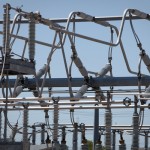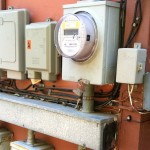Some Good News For the Texas Grid: We’ve Got a Few More Years Until Things Get Dicey

Photo by Leon Neal/AFP/Getty Images
Good news for Texans: there's likely to be more power available over the next few years than previously thought.
Texas may have some more time before its electric grid gets stretched to the point of blackouts. An updated forecast from the Electric Reliability Council of Texas (ERCOT) today says that after the announcement of several new power projects and some other revisions, the outlook for keeping the lights on over the next few years is “significantly different” than they had previously thought.
In May, ERCOT released its latest report on the state of the grid. And it caused some nervousness for saying that by 2014, the grid’s reserve margin would fall below ten percent. The reserve margin is the amount of excess power available at times of peak demand, and the state has a goal of keeping it above 13.75 percent. The further the reserve margin falls, the greater the chance of blackouts when Texas has periods of extreme weather and unexpected power plant shutdowns.
Part of the issue behind the state’s power woes of late is that low natural gas prices (thanks to a fracking boom) also mean lower profits for power producers, as natural gas tends to set the price they can charge for power. In the mostly deregulated Texas market, power plants are built privately. Without the promise of profit, plants simply weren’t being funded. So this summer, the Public Utility Commission of Texas raised the rates power companies can charge during times of peak demand to encourage new generation.
Now several new power plants and projects are under construction, with three major natural gas units expected to come online towards in the second half of 2014. But it isn’t clear if these are the direct result of the higher prices put into place. Two of the plants were announced back in 2010, but funding dried up during the recession and only recently came back. The other unit is a replacement for an older natural gas power plant.
Another reason the estimates of power supplies have changed is because forecasts of economic growth in the state have turned out to be on the higher end. Growth has actually ended up falling within the level of some of the lower forecasts, according to the report today, which means less energy demand than expected. ERCOT says that if they use the lower economic forecasts for planning, the reserve margin of power improves.
Also helping the situation is that some “peaking” units, small natural gas plants that fire up during peak demand, are also set to come on line, and several wind and solar projects are coming into the mix.
Yet the extra breathing room isn’t likely to last long. Texas’ population is set to double over the next fifty years, and companies are flocking to set up shop in the state. By 2015, the reserve margin is set to dip below its target, even with the new generation factored in, and it isn’t clear if the new plants needed to get above the line will fire up in time for the peak of summer 2014. But the updated forecast does potentially give the market and regulators more time to come up with more solutions to the state’s power crunch beyond simply raising prices.
ERCOT says today’s report is a preliminary estimate, and they’ll release a full update in December.



